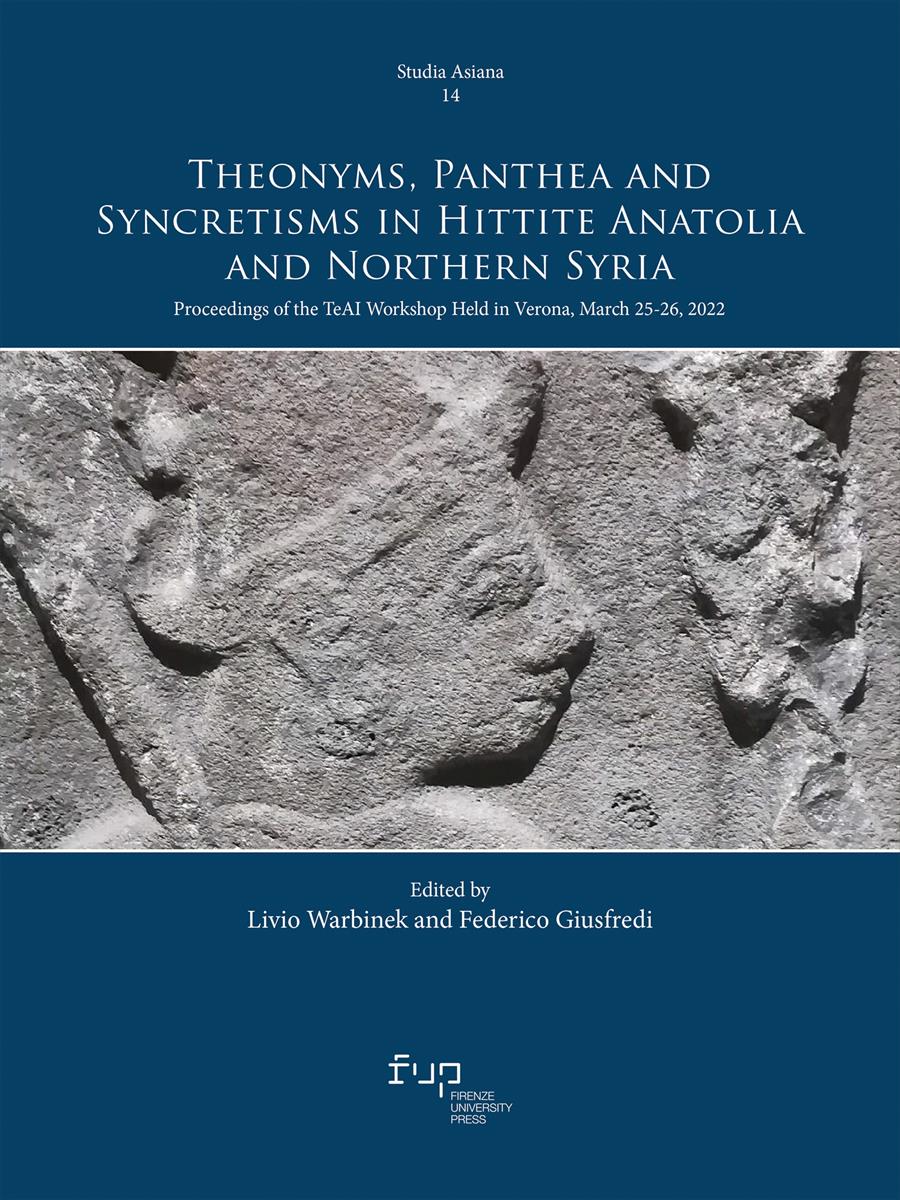- Theonyms, Panthea and Syncretisms in Hittite Anatolia and Northern Syria
- Edited by Livio Warbinek, Federico Giusfredi
Išḫara: One Deity – Many Aspects?
- Doris Prechel
- © 2023 Author(s) |
- CC BY 4.0
- DOI: 10.36253/979-12-215-0109-4.14
The goddess Išḫara is attested early in cuneiform sources, and her cult can be traced back in all regions of the Ancient Near East over a period of more than 2000 years. From this point of view, it is worthwhile to look at her integration into the Hittite pantheon and try to identify changes and continuities in her figure and present some ideas about the circumstances under which the process of integration took place.
- Keywords:
- Išḫara,
- mothergoddess,
- religious infiltration,
- local avatars,
University of Mainz Johannes Gutenberg, Germany
- Archi, Alfonso. 2020. “Išḫara and Aštar at Ebla: Some Definitions.” In The third millennium: studies in early Mesopotamia and Syria in honor of Walter Sommerfeld and Manfred Krebernik, eds. Iliya Arkhipov, Leonid Kogan, and Natalia Koslova, 1-34. Leiden: Bosten.
- Bachvarova, Mary R. 2019. “Towards an Understanding of the Gendered Hittite Landscape: What does it mean when moutains give birth?” In Acts Of The IXth International Congress of Hittitology. Çorum, September 08-14, 2014, eds. Yayına Hazırlayan, and Aygül
- Beckman, Gary M. 2014. The babilili-Ritual from Hattusa (CTH 718). Winona Lake: Eisenbrauns (MC 19).
- de Martino, Stefano. 2019. “The Hurrian Song of Release and the Fall of Ebla.” In Studies on the Archaeology, History, and Philology of Ancient Syria, ed. Paolo Matthiae, 123-155. Wiesbaden: Harrassowtiz (Studia Eblaitica 5).
- Eidem, Jesper. 2011. The Royal Archives from Tell Leilan. Leiden: Peeters (PIHANS 117).
- Garelli, Paul. 1965. “Tablettes Capadociennes de collection diverses.” Revue Assyriologiques 59: 149-76.
- George, Andrew R. 2003. The Babylonian Gilgamesh Epic. Introduction, Critical Edition and Cuneiform Texts. Volume I. Oxford: University Press.
- Hilgert, Markus. 1994. “erubbatum im Tempel des Dagān.” Journal of Cuneiform Studies 46: 29-39.
- Hinz, Walter. 1967. “Elams Vertrag mit Naram-sin von Akkade.” Zeitschrift für Assyriologie 58: 66-96.
- Kozuoğlu, Remzi. 2016. “Eski Asur kaynaklarında tanriça İšḫara ve akrep sembolü, Archivum Anatolicum 10: 29-54.
- Krebernik, Manfred. 1984. Die Beschwörungen aus Fara und Ebla. Hildesheim-Zürich-New York.
- Lambert, Wilfred G., Millard, Alan R., Miguel, Civil. 1969. Atra-Ḫasīs: The Babylonian Story of the Flood. Oxford: Eisenbrauns.
- Litke, Richard L. 1998. A Reconstruction of the Assyro-Babylonian God-lists: AN, DA-nu-um and AN: anu ša amēli. New Haven: Yale University Press.
- Matthiae, Paolo. 2010. “The Seal of Ushra-samu, official of Ebla, and Ishkhara’s Iconography.” In Opening the Tablet Box. Near Eastern Studies in Honor of Benjamin R. Foster, eds. Sarah Melville, and Alice Slotsky, 271-90. Leiden–Boston: Brill (CHANE 42).
- Miller, Jared L. 2004. Studies in the Origins, Development and Interpretation of the Kizzuwatna Rituals. Wiesbaden: Harrassowitz (StBoT 46).
- Neu, Erich. 1996. Das hurritische Epos der Freilassung. I. Untersuchungen zu einem hurritisch-hethitischen Ensemble aus Ḫattuša. Wiesbaden: Harrassowitz (StBoT 32).
- Pettinato, Giovanni. 1982. Testi lessicali bilingui della biblioteca L. 2769. Napoli: L’Orientale Università degli Studi di Napoli.
- Prechel, Doris. 1996. Die Göttin Išḫara. Ein Beitrag zur altorientalischen Religionsgeschichte. Münster: Ugarit-Verlag.
- Richter, Thomas. Forthcoming. “Theophore Personennamen in den Texten vom Haft Tappeh. Ein Zwischenbericht.” In Elam und seine Nachbarn - eine wechselvolle Beziehung. Tagungsakten des X. Colloquiums der Deutschen Orientgesellschaft, eds. Doris Prechel, and Alexander Pruß. Wiesbaden.
- Sallaberger, Walther. 1996. “Sign List: Palaeography and Syllabary.” In Administrative Documents from Tell Beydar (Seasons 1993-1995), eds. Ismail Farouk, Walther Sallaberger, Philippe Talon, and Karel Van Lerberghe, 33-67. Turnhout: Brepols.
- Salvini, Mirjo. 2015. Les textes hourrites de Meskéné/Emar 2. Thesaurus. Roma: Pontificio Istituto Biblico.
- Schwemer, Daniel. 2008. “Fremde Götter in Ḫatti. Die hethitische Religion im Spannungsfeld von Synkretismus und Abgrenzung.” In Ḫattuša – Boğazköy – Das Hethiterreich im Spannungsfeld des Alten Orients. 6. Internationales Colloquium der Deutschen Orient-Gesellschaft 22.-24. März 2006, Würzburg, ed. Gernot Wilhelm, 137-58. Wiesbaden: Harrassowitz (CDOG 6).
- Schwemer, Daniel. 2013. “Gauging the influence of Babylonian magic: The reception of Mesopotamian traditions in Hittite ritual practice.” In Diversity and Standardization. Perspectives on social and political norms in the ancient Near East, eds. Jörg, Klinger, Eva Cancik-Kirschbaum, Gerfrid G.W. Müller, 145-71. Berlin: Akademie Verlag.
- Seidl, Ursula. 1989. Die babylonischen Kudurru-Reliefs. Symbole Mesopotamischer Gottheiten. Freiburg–Göttingen: Ruprecht (OBO 87).
- Veenhof, Klaas R. 2018. “The Family God in Old Babylonian and Especially in Old Assyrian Sources.” Revue Assyriologique 112: 49-90.
- Von Dassow, Eva. 2013. “Piecing together the Song of Release.” Journal of Cuneiform Studies 65, 127-62.
- Weiershäuser, Frauke. 2008. Die königlichen Frauen der III. Dynastie von Ur. Göttingen: Universitätsverlag.
- Westenholz, Joan, and Westenholz, Aage, 1977. “The Old Akkadian Love Incantation MAD v 8.” Orientalia 46: 98-219.
Chapter Information
Chapter Title
Išḫara: One Deity – Many Aspects?
Authors
Doris Prechel
Language
English
DOI
10.36253/979-12-215-0109-4.14
Peer Reviewed
Publication Year
2023
Copyright Information
© 2023 Author(s)
Content License
Metadata License
Bibliographic Information
Book Title
Theonyms, Panthea and Syncretisms in Hittite Anatolia and Northern Syria
Book Subtitle
Proceedings of the TeAI Workshop Held in Verona, March 25-26, 2022
Editors
Livio Warbinek, Federico Giusfredi
Peer Reviewed
Number of Pages
194
Publication Year
2023
Copyright Information
© 2023 Author(s)
Content License
Metadata License
Publisher Name
Firenze University Press
DOI
10.36253/979-12-215-0109-4
ISBN Print
979-12-215-0108-7
eISBN (pdf)
979-12-215-0109-4
Series Title
Studia Asiana
Series ISSN
1974-7837
Series E-ISSN
2612-808X
